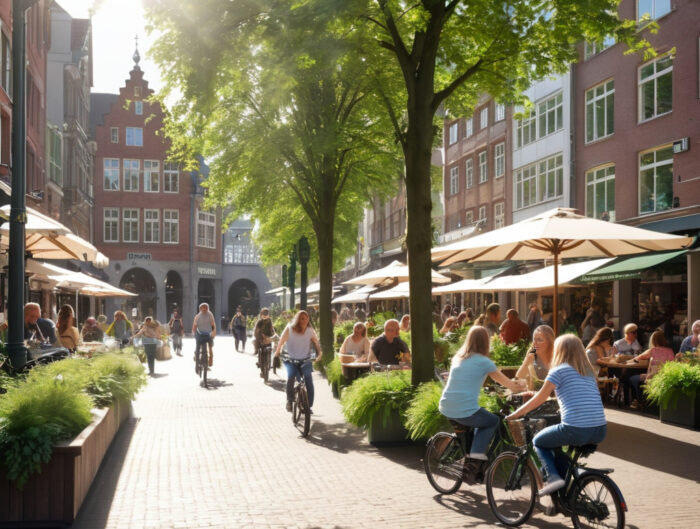Oldenburg is an ideal destination for a weekend getaway. With its rich historical past, its numerous art museums and unusual outdoor activities. The city with its charming alleys has no shortage of diverse and varied offerings. A travel guide for a pleasant stay.
Located 30 min away from Bremen and 1h30 away from Hamburg by train, Oldenburg is a fantastic getaway for the day or for the weekend. Very famous in the past, the city is less known nowadays for a short trip. Even the travel guides seldom mention the town, although it has much to offer. Here are some reasons to discover this pleasant city, the perfect compromise between city life and life in nature. A guide to what to see and do in this multifaceted city.
Historically, the city is less known because Oldenburg flourished in the shadow of the much more powerful hanseaticcity of Bremen. Yet, its past deserves attention as it was, for a long time, attached to the dukes and nobles. Indeed, Oldenburg became a grand duchy of Danish kings. The counts of Oldenburg from the Danish monarchy protected their land throughout the years by offering gifts to the population. However, the Great Fire of 1676 triggered numerous economic and human losses. Also, from 1810 to 1813, the city belonged to the French Empire when it was annexed by France. It was only when Friedrich August abdicated in 1918 that Oldenburg became a city and a « Free State ». The monarchic rule ended so. The landmarks of five centuries of history characterise the actual buildings, such as the row of classicist houses on Hunterstraße from the 18th century, the Palace, the Guard Palace (1839), and the Saint Lamberti church from the 12th century. The destroyed buildings were rebuilt in a neoklassizistisch style, which explains the city centre’s classical atmosphere.

The city’s assets are numerous: natural, sporting, cultural, gastronomic and musical.
As far as cultural venues are concerned, the city is full of them: Oldenburg is considered the region’s city of art and culture, with many interesting events. Museums, libraries and theatres, including a seven-hall national theatre, combine tradition and modernity. Concerning the museums, the Horst Janssen Museum and the Edith Russ House are just two of the most important exhibition centres. The first one is dedicated to the draftsman that grew up in Oldenburg and focused on fine art on paper and explored the limits of graphic art. The second one regularly exhibits innovative and experimental contemporary art. The museum chooses the subject of communication that deals with the media in contemporary art practice – in honour of the teacher Edith Russ who dedicated her fortune to « for art in the transition to the new millennium ». And for those who want to follow in the footsteps of Atari, Commodore and Super Nintendo, the Computer Museum in Oldenburg – one of Germany’s largest museums dedicated to personal computers – is the place to be.
Also, how to not mention the Schloss of Oldenburg with its breathtaking beauty – mixed with historicist and rococo style – which is today housing the state museum for Art and Cultural History, specialised in decorative arts and in old masterspaintings. From medieval handwritten documents to Bauhaus design, the castle displays a variety of art. The Prinzenpalais, however, is dedicated to modern art with the impressionists. If you’re coming for a weekend, try the Artothek of Oldenburg, which is an educational institution that supports regional artists in particular by purchasing, presenting and lending works of art. With a collection of 2,000 works by over 600 artists, making it the largest art library in Lower Saxony, visitors are encouraged to take the sculptures off their pedestals in order to experience art in an unconventional way.

For nature lovers, Oldenburg also has many parks with outdoor activities. And surprising ones. For example, city paddling on the Hunte is possible. Also, a dense network of cycle paths takes visitors past farmhouses and colourfulrhododendron hedges through extensive moorland, forests, meadows, and along dykes and canals to the ZwischenahnerMeer. Oldenburg can be described as a city in the countryside as it truly coexists with nature. The city is divided by 16 green axes where it is possible to cycle, walk, rollerblade… The « Grüne (Wege)Stern » project connects all these places, and thanks to this, walking in nature is even more ergonomic. Existing green spaces such as parks, public squares, green streets, fields and meadows are connected by this particular system. Cycling is by far one of the top activities of leisure in the town. In addition, the Landschaftspark Mühlenhuntefunctions as a proper green city with its 6 hectares of lush flora. Lovers of water and swimming will opt more for Bornhoster Seen with its peaceful landscape. Last but not least, the Eversten outdoor playground is also great for children. This educational facility houses a cosy reading corner, a workshop, a dream room and an activity room with a climbing wall.
Local markets and cozy cafés
So much activity whet the appetite, which is fortunate because we’ve made a selection of cafes and restaurants to enjoy. The typical German Ratskeller in a subdued atmosphere with good wine is a decent option to live the whole German experience. In the same style, Hans im Glück, where you have the impression of eating in an old-fashioned tavern. The Calderorestaurant is different with its brickwork and delicious tapas but is also worth the visit. For a sweeter palate, Oldenburg is filled with adorable cafes. Carusi, an Italian place – which also serves as a restaurant – delights the straws of everyone with homemade choux and gourmet tarts. Kaffee Hamburg is the perfect tea room where you feel whole around rhubarb pies. And the Innenleben Cafe, for its soothing outdoor setting with a hidden courtyard, is a great option.
Moreover, take a look at the city market in front of the church every day (except Mondays and Wednesdays), where you can purchase local food and clothes while talking to the producers. Otherwise, there are annual theme markets such as the Christmas market, the ceramics market in August, and the Nikolai Markt for handicrafts. After this non-exhaustive overview, here is an example of a typical day in Oldenburg :
Start your day with a lovely hot chocolate with marshmallows or coffee with cream accompanied by a homemade pie with seasonal fruits, all in a cosy and warm atmosphere in KaffeeHamburg. Then walk through the Saint-Lamberti Church to observe the stained glass windows. Continue along the pedestrianised streets, full of charm, for a pleasant return to the past, and make an obligatory stop to admire the Degodehaus. Lose yourself in the Schloss, the city’s classic, fairytale-like castle and admire the artworks. The Prinzenpalais is also a thoughtful idea for the more daring. A lunch break at the Zum Droegen Hasen is needed to gain strength before embarking on a tour of the castle’s gardens with its thatched cottages hidden in the middle of the park and its beautiful greenhouses. Alternatively, the botanical gardens are the perfect place to recharge your batteries. Finally, a special mention goes to the Pretty Different thrift shop, which is full of vintage gems, all decorated in the Art Nouveau style. You feel right at home here. For a souvenir, Lade Nr. 5 is the place to go for practical, handmade everyday objects.
The Lower Saxony region is full of small, lesser-known, yet charming places. Where should we go next? What is the next discovery?
Von Agustina Erneta











